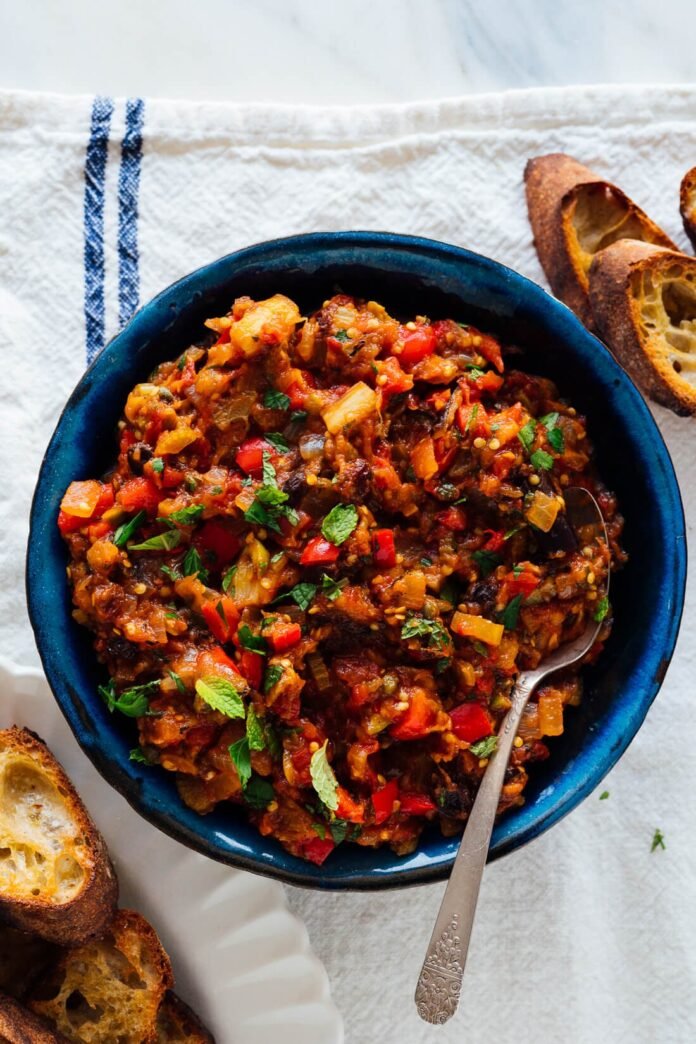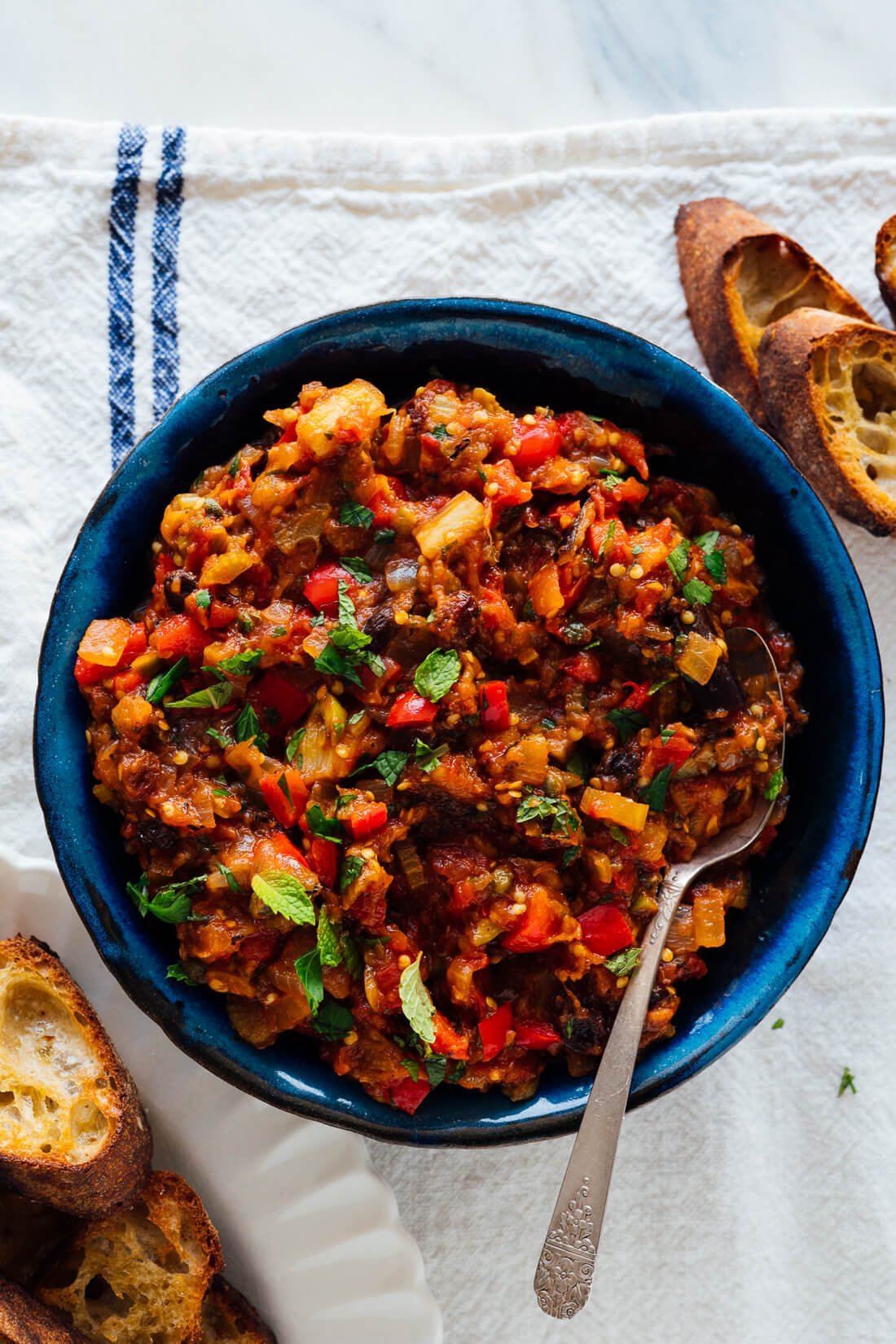
Let’s make homemade caponata! This classic Sicilian appetizer or side dish is perfect for late summer meals. This recipe combines roasted (not fried) eggplant with sautéed bell pepper, celery, tomatoes, olives and capers. Red wine vinegar and honey make it irresistibly tangy and sweet. If you generally enjoy these bold flavors, you’re going to love caponata.
Since international travel is largely off the table, I’ve been traveling vicariously through my food. This caponata is the perfect example. I’ve yet to make my way to Sicily to sample authentic caponata, but learning to make this dish has deepened my desire to explore the island. Mark my words, I’ll get there someday.

Caponata recipes vary from region to region and household to household. This recipe is where I landed. I took some cooking cues from my ratatouille recipe, which also features roasted eggplant stirred into a simmering tomato sauce. Caponata’s flavors are even deeper and more complex largely due to the intense agrodolce factor, or the interplay between sweet (honey and raisins) and sour (vinegar and capers).
I can’t claim this recipe is entirely authentic, but I hope it offers you a little taste of Sicily.

How to Serve Caponata
Caponata is a fun and versatile dish whether you serve it as an appetizer, a side dish or a light meal. Traditionally, caponata was served alongside fish or meat dishes. Caponata offers bold, lively flavors that will complement grilled entrées and late summer feasts, and it packs well for picnics.
Caponata is a great make-ahead dish. To give the flavors time to mingle, let it chill in the fridge for a couple of hours or ideally, a full day. I prefer my caponata warmed or at room temperature, but some enjoy it cold. I believe caponata would freeze well for later if you’d like to preserve a taste of late summer. Bottom line—do as you please!
Watch How to Make Caponata
Wondering what to eat with caponata? Here are some suggestions:
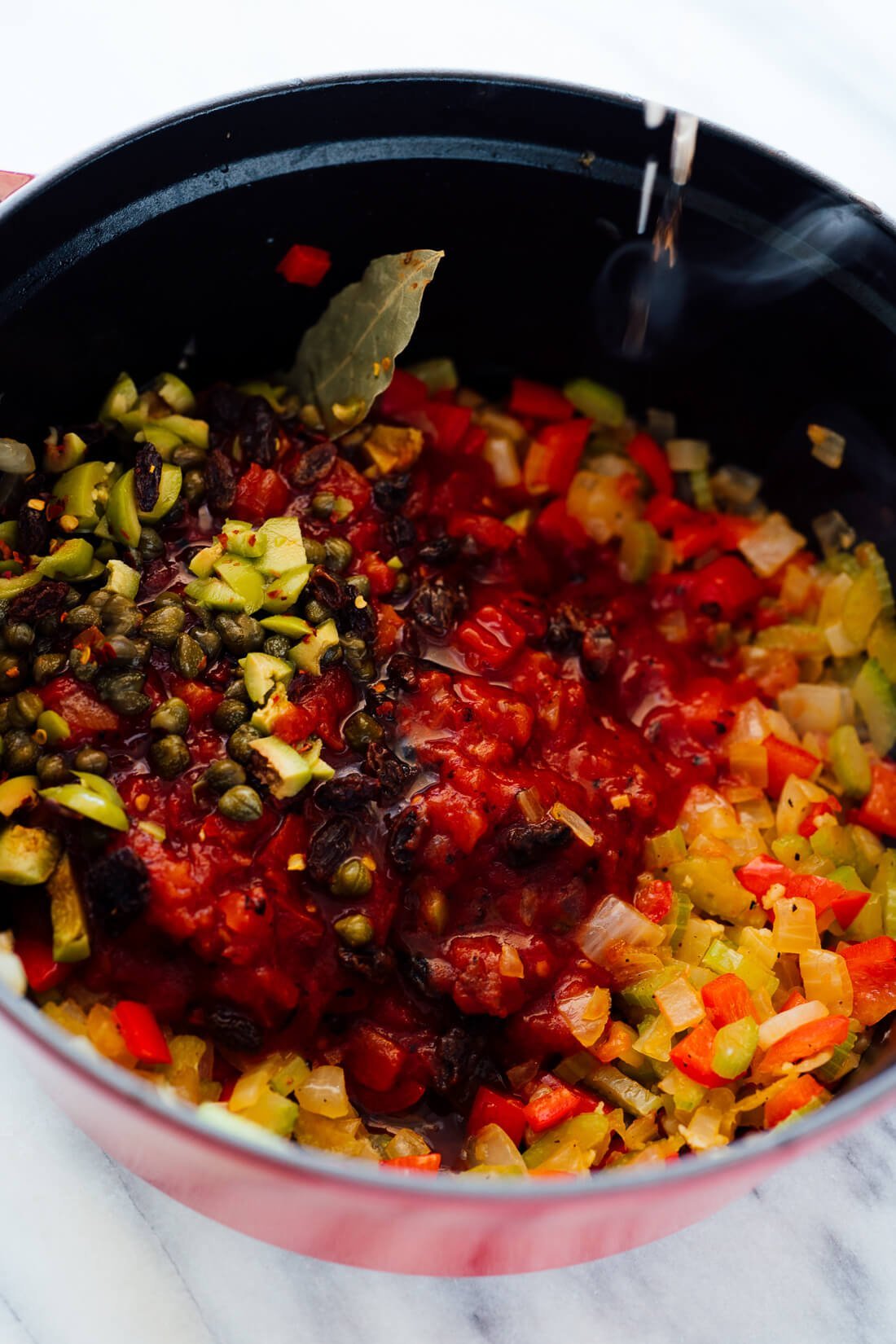
Some Brief Caponata History
For context, Sicily is the largest island in the Mediterranean Sea, located just south of Italy. Over many centuries, Sicily was invaded by the Phoenicians, Greeks, Romans, Arabs, Normans (French) and Spaniards. Each culture left a mark on Sicilian cuisine.
In my research, I’ve learned that caponata is as diverse as the history of Sicily. Caponata inherited eggplant and its sweet and sour (agrodolce) flavor from the Arabs, olives from the Greeks, and tomatoes from Italy (or are they from Spanish aristocrats?). The recipe seems to have drawn inspiration from vegetable dishes of Spain (pisto manchego) and France (ratatouille) as well. Even the roots of the name caponata are highly debated.
Recommended Reading on Caponata & Sicilian Cuisine
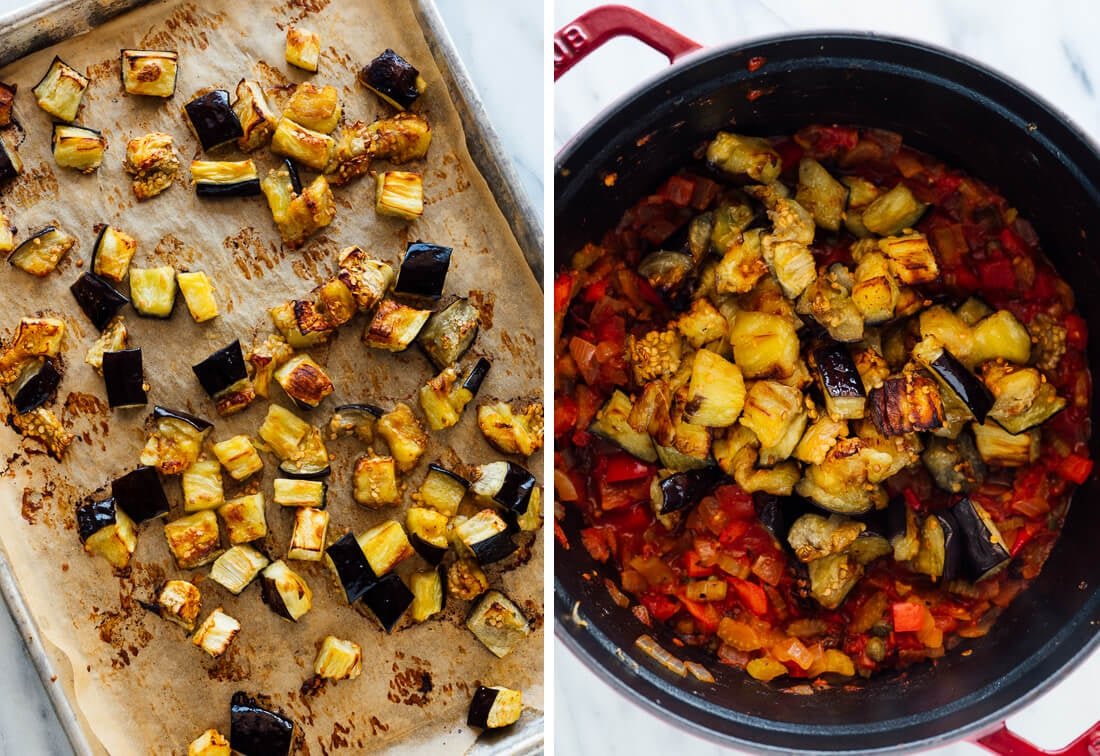
How to Make Caponata
You’ll find the full recipe below, but here’s the gist:
- Roast the eggplant. Traditionally, caponata is made with fried eggplant. Since eggplant soaks up oil like a sponge, I’ve significantly lightened up this dish by roasting the eggplant in a few tablespoons of oil instead. Roasted eggplant is golden, caramelized and beautifully suited for caponata. No need to salt the eggplant beforehand.
- Prepare and cook the onion, celery and bell pepper. Since the eggplant requires about 30 minutes in the oven, we’ll have time to chop these vegetables and get them going.
- Add garlic, followed by crushed tomatoes. We’ll sauté the garlic just long enough to enhance its flavor before pouring in the tomatoes.
- Then add olives, raisins, vinegar, capers, honey, red pepper flakes and bay leaf. This is a lot to add at once—you can combine all of these in a bowl in advance to streamline this step.
- Stir in the roasted eggplant, followed by a handful of fresh herbs. Almost done! Now you can tweak the flavors to make your caponata taste just right. If you have the time, let the caponata chill in the fridge for several hours, or overnight, before serving. I love it freshly made, too, though.
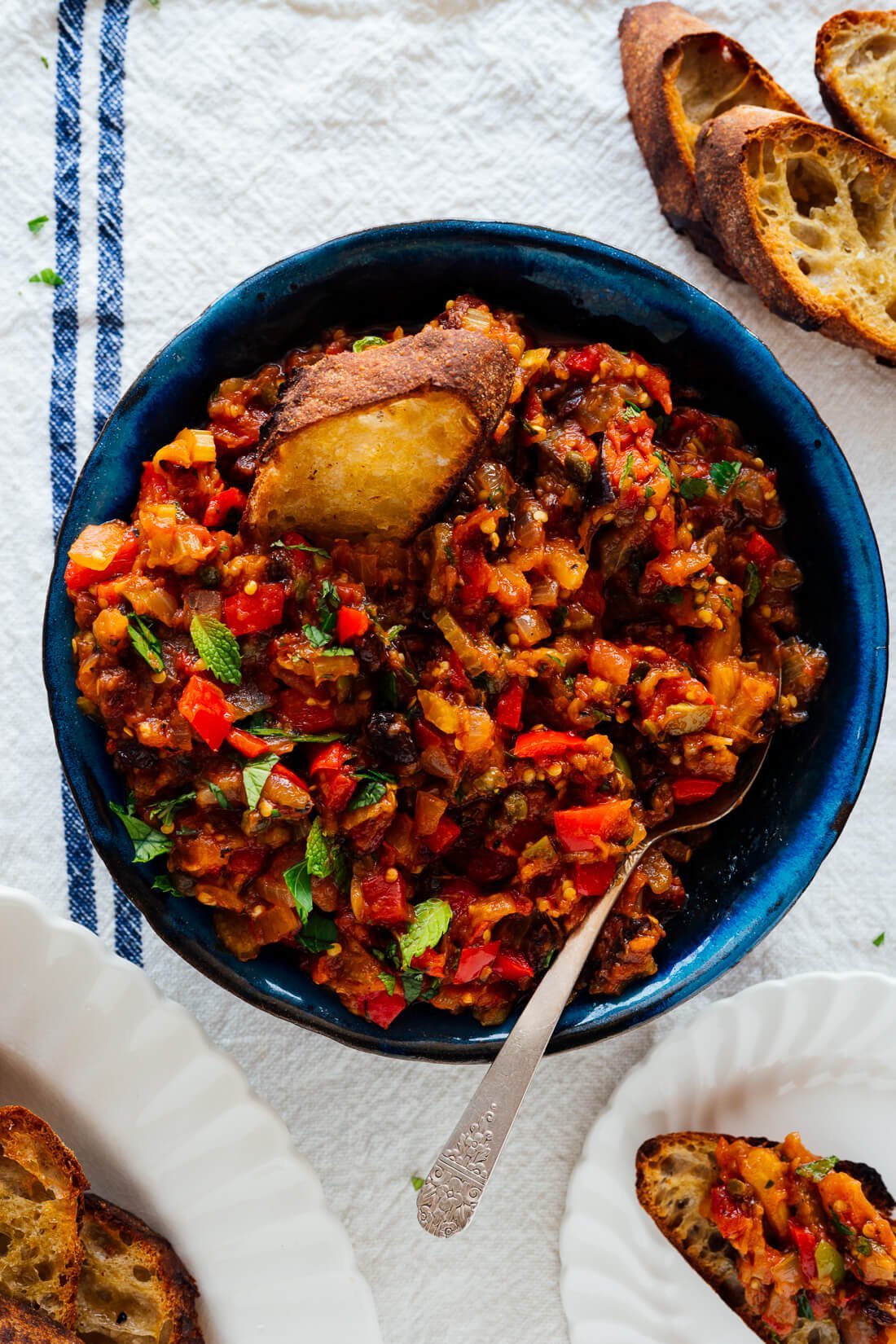
More Eggplant Recipes to Enjoy
As always, please let me know how you like your caponata in the comments! I love hearing from you.
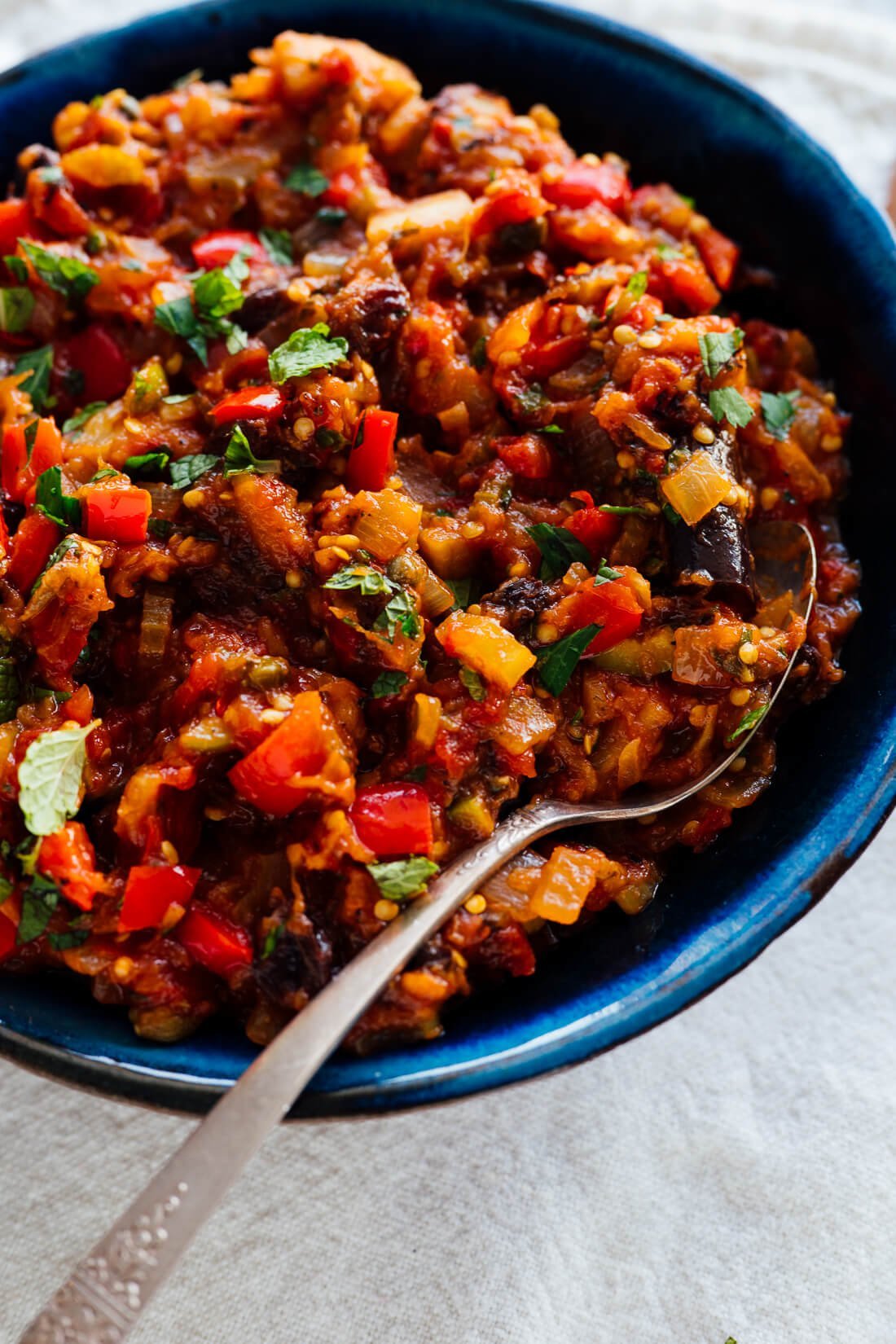
Caponata
Learn how to make homemade caponata with this recipe! This boldly flavored Sicilian appetizer or side dish is perfect for late summer meals. Recipe yields about 6 side servings.
- 1 large or 2 smallish eggplants (about 1 ¾ pounds), cut into 1-inch cubes
- ½ teaspoon fine salt, divided, to taste
- 4 tablespoons extra-virgin olive oil, divided
- 1 medium yellow onion, chopped
- 1 red bell pepper, chopped
- 2 celery stalks, thinly sliced
- Freshly ground black pepper, to taste
- 2 cloves garlic, pressed or minced
- 1 can (14 ounces) crushed fire-roasted tomatoes
- ¼ cup pitted green olives (ideally Castelvetrano), roughly chopped
- ¼ cup raisins, red or golden
- 3 tablespoons red wine vinegar or white wine vinegar, to taste
- 2 tablespoons capers, drained
- 1 tablespoon honey or sugar, to taste
- ¼ teaspoon red pepper flakes, to taste
- 1 bay leaf
- ¼ cup chopped fresh mint, flat-leaf parsley and/or basil
- Homemade Crostini, optional, for serving
- Preheat the oven to 425 degrees Fahrenheit. Line a large, rimmed baking sheet with parchment paper to prevent the eggplant from sticking to it.
- Place the cubed eggplant on the prepared pan. Sprinkle it with ¼ teaspoon of the salt, drizzle with 3 tablespoons olive oil, and promptly toss to coat (some of the eggplant pieces will be more saturated with oil than the others, and that’s ok). Roast the eggplant in the oven for 30 to 35 minutes, stirring halfway, until deeply golden.
- In the meantime, warm the remaining tablespoon of olive oil in a medium Dutch oven or heavy-bottomed saucepan over medium heat. Add the onion, bell pepper and celery. Season with the remaining ¼ teaspoon salt and about 10 twists of black pepper. Cook until the onions are tender and just starting to turn golden, about 9 to 12 minutes, stirring often.
- Add the garlic and stir until fragrant, about 30 seconds. Add the tomatoes and stir to combine. Add the olives, raisins, vinegar, capers, honey, red pepper flakes, and bay leaf. Stir to combine. Simmer on medium-low heat for 10 minutes or so, stirring occasionally.
- Remove and discard the bay leaf. Stir in the roasted eggplant and cook for another 2 to 3 minutes. Stir in most of the fresh herbs, reserving a small handful for garnish. Remove the pot from the heat.
- Adjust to taste to find your desired balance of tangy-sweet-spicy-salty. Add more vinegar (by the tablespoon), honey (by the teaspoon), red pepper flakes (I like at least ¼ teaspoon more, but I like spice), and/or salt (for more overall flavor). Transfer it to a serving bowl and top with the remaining herbs.
- For best flavor, allow the caponata to rest at room temperature for an hour, or longer in the refrigerator. Serve warm or at room temperature (some even enjoy it chilled), with crostini if desired. Caponata will keep for about 5 days, covered, in the fridge. I suspect it would freeze well for several months, too.
Notes
Change it up: Aside from the eggplant and tomatoes, the vegetables here are flexible—you could add an extra bell pepper or omit the bell pepper entirely. You could add some carrot or zucchini or yellow squash. If you don’t like raisins, leave them out. Not all caponata recipes call for them, anyway. You might enjoy pine nuts sprinkled on top, which is another regional variation.
Make it vegan: Substitute sugar for the honey.
Make it gluten free: This dish is gluten free, as long as you serve it with gluten-free accompaniments.
Nutrition
The information shown is an estimate provided by an online nutrition calculator. It should not be considered a substitute for a professional nutritionist’s advice. See our full nutrition disclosure here.

